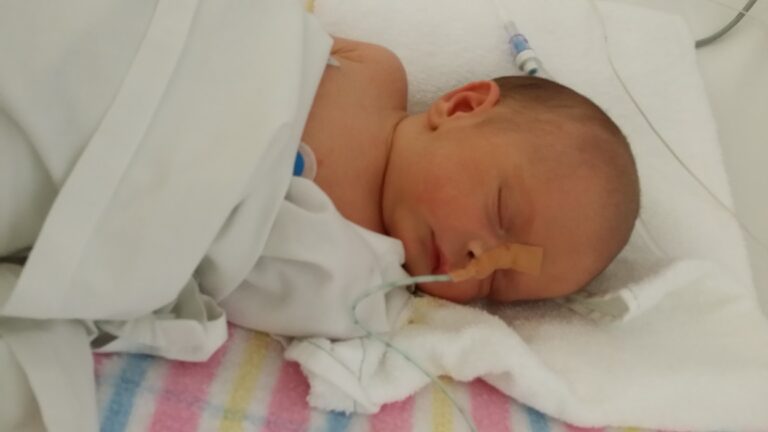Our HFI Journey
Our journey with Hereditary Fructose Intolerance (HFI) has been anything but easy, but it has shaped who we are today. As a mother of two incredible children with HFI, I know firsthand how overwhelming and challenging this diagnosis can be. That’s why I created @hfiinthekitchen—to help create awareness, share our experiences, and help other families navigate a fructose free lifestyle with confidence.
Over the years, I have had many parents and individuals who suspect they may have Hereditary Fructose Intolerance reach out to me on my social media pages. The two main questions that I am asked is – “How were your children diagnosed?” and “What were their symptoms?”. It sparked an idea — this could be the perfect first story to share on my HFI Blog. I hope that our story can help someone with their journey and hopefully avoid some of the struggles we experienced.
Jackson’s Journey to Diagnosis
From the moment I found out I was pregnant I imagined what it would be like when I met my baby boy. It was magical, holding this gorgeous little boy that we had created in my arms. A moment that will stay with me forever. I could never have imagined what would happen next. Our son’s struggles began from the moment he was born. He was failing to thrive, unable to maintain his body temperature, couldn’t stabilise his blood sugar levels and wasn’t able to hold any milk down. This alone was terrifying as a first-time mum. I was also very unwell with preeclampsia that came on rapidly during labour. I was rushed off to the Intensive Care Unit and Jackson was taken to the Special Care Nursery for close monitoring and investigation. We were separated – not exactly what I had pictured for our journey, but I took solace in knowing that we were in good hands. I spent three days in the Intensive Care Unit then was moved to the ward for a couple of days and discharged home without my little boy. I was scared and truly heartbroken having to go home without my baby especially when he was so unwell. It was a roller-coaster that I wasn’t prepared for; however, I was ready to tough it out and do whatever I had to do to help my baby boy come home.
While Jackson was in the Special Care Nursery, he was given sucrose to soothe him prior to procedures like blood tests. In Australia it is normal practice for newborns to be given sucrose in the Special Care Nursery for procedures to soothe them and keep them calm. Unfortunately, the worst possible thing for someone with HFI is sucrose, especially if they are failing to thrive. Naturally, his condition only worsened, and he spent the first 10 days of his life undergoing countless tests from Barium swallow x-rays to blood work and tube feeding. One of the biggest challenges was that he couldn’t keep any food down. This was a chronic problem for baby Jackson and was managed initially by tube-feeding but escalated to the point where they took the food away and had him on IV drips and he was still bringing up fluid. This was what lead to the Barium swallow which essentially confirmed that there was no structural issue but likely reflux. Seeing my beautiful little boy so unwell was a feeling of helplessness that I will never forget. The fear of the uncertainty and desperately searching for hope, I spent every waking moment by his side.
Jackson was discharged with no real answers as to why he so unwell and his blood work became a bit of a mystery to the medical staff. They couldn’t figure out what was going on, nothing was adding up. In hindsight this is largely due to the fact that they were giving him sucrose for his blood work, and it was likely interfering with the testing results. None the less, I was ecstatic about bringing my boy home for the first time.
Once we brought him home, things didn’t really improve. I tried to breastfeed him but unfortunately it didn’t work for us. After another hospital admission, I decided that it was time to give up on breastfeeding and give formula a try. Unfortunately, Jackson was put on a formula containing fructose. This led to severe vomiting, painful bloating, and sleepless nights filled with gut pain and explosive diarrhea. We tried everything to soothe him, but nothing would work. My husband and I would spend most nights taking turns with Jackson’s Nanna and Grandad, walking the hallways at home with him screaming in agony for hours and hours until he would have an explosive diarrhea or projectile vomiting. Then the poor little guy would crash from pure exhaustion and sleep for a couple of hours before we would start our day. It didn’t take long for me to realise that this was not normal and then my husband and I started to question everything. I would tell the General Practitioners that Jackson would vomit up most of his bottle every single feed and was told that this was not possible and that he was ‘positing’. They explained ‘positing’ as a teaspoon sized vomit that appears larger because it is fluid in movement. Because he was gaining just enough weight to scrape by on the scales and was hydrated, there seemed to be no real concern regarding the vomiting or bloating, and it was put down to reflux and a possible milk allergy. I was put into the basket of being a ‘nervous first-time mum’ who was overwhelmed and overreacting to symptoms. Unfortunately, it seems that this is a common theme for new mums, and it led to me not trusting my own motherly instincts.
It wasn’t until our Paediatrician appointment that things started to change. I had fed Jackson in the waiting room right before our appointment and like clockwork, we sat down in the Paediatrician’s room and up came Jackson’s bottle!! It was everywhere, he was covered in it, I was covered in it – it was all over the carpet! This was the first time that I was truly heard and understood by a medical professional. I was reassured that this was not normal and that we would need to look at his diet. We were advised to try soy formula, thinking it was a milk allergy, but this only made things worse.
I was beside myself with exhaustion and confusion. Why was this happening? Two hospital admissions, countless General Practitioner appointments, Paediatrician’s, pathology and Geneticists and we still had no real answers as to why this was happening to my poor little man.
As a toddler, Jackson refused most foods (for that I am now very thankful) and would only eat pasta, plain Greek yoghurt, cheese, chicken and a little bit of avocado. At the time, I was genuinely concerned about his lack of nutrition with his limited diet. For two years, we searched for answers. He was initially misdiagnosed with Congenital Disorder of Glycosylation (CDG) through genetic testing, but the symptoms never quite fit. We continued to be very concerned about his bloating; his stomach was so distended that he couldn’t see his feet while standing. It looked really painful and uncomfortable. Our Paediatrician listened to our concerns and decided that it was time for an abdominal ultrasound – this was the missing piece of the puzzle!
The abdominal ultrasound showed that Jackson had a fatty enlarged liver, and we were referred to the Liver Team at the Children’s Hospital Westmead. We were very lucky to see the Head Gastroenterologist in the Liver Clinic who had seen a similar misdiagnosis. The Specialist had one question… “What does your child do when you give him something sweet?”. Honestly, I could barely get him to eat anything let alone something sweet! If I somehow convinced him to try something sweet – he would spit it straight out!! The Specialist explained that when someone with Hereditary Fructose Intolerance is undiagnosed and ingests fructose, it alters the blood test results and shows a diagnosis of Congenital Disorders of Glycosylation (CDG) instead of HFI! This is caused by an accumulation of fructose-1-phosphate (F1P) which can disrupt the glycosylation process, resulting in a hypoglycosylated transferrin pattern similar to what is seen in some types of CDG. Subsequently, this overlap in transferrin patterns can lead to misinterpretations and even a misdiagnosis of CDG instead of HFI, and this is exactly what happened in Jackson’s case!
We were immediately sent off for more blood work including genetic testing for Hereditary Fructose Intolerance. After about four weeks we had a confirmed Hereditary Fructose Intolerance diagnosis. It was a relief to have answers, but heartbreaking to realise that years of unknowingly ingesting fructose had caused liver damage and potentially contributed to his low muscle tone.
I went down the rabbit hole researching the HFI diet and worked closely with a Dietician who specialised in Metabolic Disorders at the Children’s Hospital. Through research and education, I was able to navigate a whole new approach to creating safe, nourishing meals to support my son’s growth and development. It was challenging to rewire my brain to go against everything I was taught growing up – wholefoods are best, lots of fruit and vegetables, eat foods from every colour of the rainbow… This is not the case for someone with HFI, in fact it’s quite the opposite. I am confident in my ability to create HFI safe meals for my family and can’t wait to share them with you.
Jackson’s journey to diagnosis has taught me some valuable lessons about motherhood. It has taught me to trust my own instincts and has also taught me how to be a fierce advocate for my children in a world that isn’t always very understanding of those who may be a little different.
Today, we carefully monitor his health with annual blood tests and liver ultrasounds, and he continues to see multiple specialists to support his development. We are eternally grateful to the team at the Children’s Hospital Westmead and our Paediatrician for our diagnosis and the support we continue to receive.



